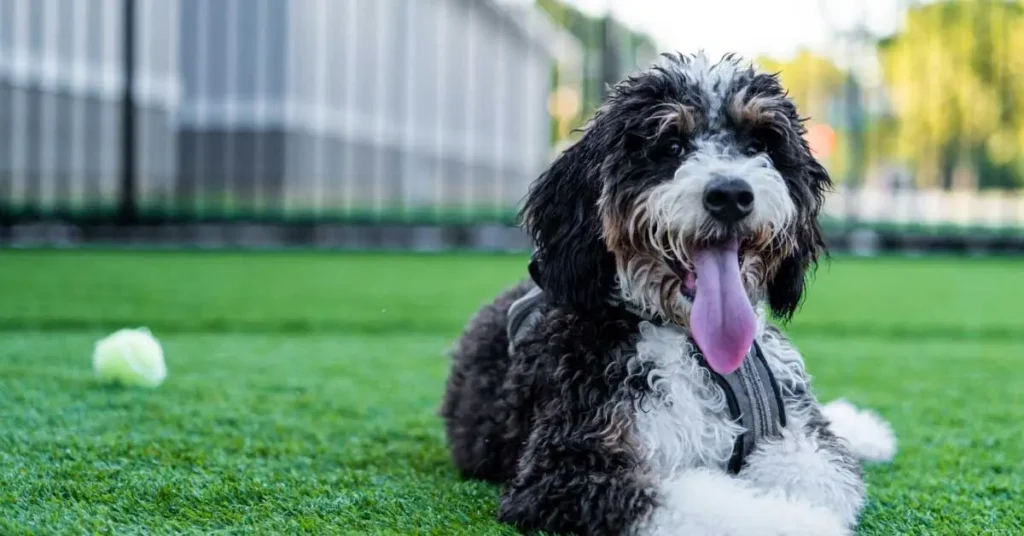Exploring the delightful world of Bernedoodles introduces a mix of excitement and complexity, especially when deciphering the mini Bernedoodle size and its variations. These charismatic dogs blend the best traits of the Bernese Mountain Dog and the Poodle, positioning them as an ideal companion for families. Yet, potential owners often find themselves navigating through the maze of sizes, from the micro mini Bernedoodle to the standard Bernedoodle, and everything in between.
Understanding the bernedoodle size comparison, including the micro mini bernedoodle size and mini bernedoodle size comparison, is crucial as it significantly influences the dog’s compatibility with an owner’s lifestyle, available space, and even the bernedoodle lifespan.
This article is designed to offer an in-depth mini bernedoodle size comparison, highlighting the key differences between the mini Bernedoodle and micro mini Bernedoodle. We’ll dive into each variety, outlining their distinct size, temperament, and lifestyle needs. Additionally, we’ll provide a mini Bernedoodle size chart and insights for selecting the perfect Bernedoodle size for your family.
Whether you’re consulting with Bernedoodle breeders, considering adding Bernedoodle puppies to your family, or just curious about the various Bernedoodle sizes, this guide aims to equip you with the knowledge to make an informed decision that aligns with your needs and expectations.
Understanding Mini Bernedoodles
Mini Bernedoodles, the charming hybrid offspring of the Bernese Mountain Dog and the Miniature Poodle, are celebrated for their compact size and charismatic nature. This section explores the essential aspects of Mini Bernedoodles, including their size and weight, distinctive characteristics, exercise needs, and grooming requirements.
Understanding how big a mini bernedoodle gets and the typical mini bernedoodle weight can help potential owners gauge if this breed’s compact nature aligns with their lifestyle.
Size and Weight
Mini Bernedoodles typically stand between 18 to 22 inches tall at the shoulder and weigh between 25 to 50 pounds. The size of these delightful dogs can vary significantly, even within the same litter, primarily due to the size of the parent breeds.
It’s important for future owners to realize that while Mini Bernedoodles generally stop growing in height by 11 to 12 months, they continue to develop in muscle mass and weight until about 14 to 16 months. This insight into how big do mini bernedoodles get and the mini bernedoodle weight progression is vital for understanding the breed’s development.
Typical Characteristics
Mini Bernedoodles are known for their intelligence and playful nature, making them excellent family pets. They are often described as sociable and adaptable, able to thrive in various living environments, from apartments to larger homes. Their coat, which can be curly, wavy, or straight and comes in a range of colors including black, brown, white, or a mix, reflects their Poodle and Bernese lineage. The bernedoodle colors and their adaptable bernedoodle temperament make them great companions for children and other pets.
Exercise Requirements
To maintain their health and happiness, Mini Bernedoodles require regular physical activity. Engaging in at least an hour of exercise daily supports their energetic nature. This can include walks, runs, or play sessions in a safe, enclosed area. Their affinity for activities like swimming, a trait likely inherited from their Poodle ancestors, is also notable.
Regular exercise not only keeps them fit but also strengthens the bond between the dog and its owner, underscoring the importance of bernedoodle exercise.
Grooming Needs
The grooming needs of Mini Bernedoodles vary with their coat type. Those with curlier coats, resembling their Poodle relatives, tend to shed less and may be more suitable for allergy sufferers. However, all Mini Bernedoodles require regular mini bernedoodle grooming to prevent matting and tangling of their fur.
Brushing a Mini Bernedoodle’s coat two to three times per week and scheduling regular grooming sessions are essential to keep their coat neat and tidy. This grooming routine not only keeps the dog comfortable but also aids in maintaining overall skin health, highlighting the significance of bernedoodle grooming practices.
Understanding these aspects of Mini Bernedoodles can help potential owners decide if this breed is the right fit for their lifestyle and provide the best care for these affectionate and lively companions.
Understanding Micro Bernedoodles
Micro Bernedoodles represent the smallest variant in the Bernedoodle family, achieved through breeding a Toy Poodle with a Miniature Bernese Mountain Dog. This combination results in a dog that inherits the compact size of the Toy Poodle along with the charming features of the Bernese Mountain Dog, making the micro bernedoodle size particularly appealing for those with limited living space.
Size and Weight
Micro Bernedoodles are notably small, typically weighing between 10 to 24 pounds and standing about 12 to 17 inches tall at the shoulder. Their diminutive stature, a result of the micro bernedoodle size and toy bernedoodle size genetics, makes them especially suitable for apartment living or for families with limited space. Despite their size, they exhibit a robust structure, influenced primarily by their Toy Poodle and Bernese Mountain Dog lineage.
Typical Characteristics
Micro Bernedoodles, known for their sociable, intelligent, and affectionate nature, inherit the best of both worlds: the intelligence of their Poodle ancestors and the friendly, goofy bernedoodle temperament of the Bernese Mountain Dogs. This blend makes them perfect companions for singles, couples, or families with older children, thanks to their adaptability to various living environments.
Exercise Requirements
Despite their compact size, Micro Bernedoodles thrive on regular physical activity to stay healthy and happy. Their daily routine should encompass walks, playtime, and mental challenges to keep them engaged. It’s essential to balance their activity to prevent overexertion due to their smaller stature, ensuring their bernedoodle exercise needs are met without pushing their limits.
Grooming Needs
The grooming needs of Micro Bernedoodles, influenced by their coat type – be it curly, straight, or wavy – are vital for their well-being. Those with curlier coats, a hallmark of the bernedoodle coat, are less likely to shed and might be a better option for allergy sufferers. Regular grooming sessions, including brushing a few times a week and occasional professional grooming, are crucial to prevent matting and keep their coat healthy.
Key Differences Between Mini and Micro Bernedoodles
Delving into the captivating world of Bernedoodles, it’s essential to understand the differences between the mini and micro sizes, especially for potential pet owners. These distinctions affect not only their physical appearance but also their lifestyle needs, such as exercise, grooming, and overall care. This exploration covers the bernedoodle size comparison, including mini bernedoodle size comparison, to highlight size, behavioral, exercise, and grooming differences.
Mini Bernedoodle Size Comparison
A key distinction between Mini and Micro Bernedoodles is their size. Mini Bernedoodles, typically weighing between 25 to 49 pounds and standing about 18 to 22 inches tall at the shoulder, contrast with the smaller Micro Bernedoodles, which weigh between 10 to 20 pounds and stand 12 to 17 inches tall. This significant size difference impacts not only their physical presence but also their living arrangements and space needs, emphasizing the importance of the micro bernedoodle size in decision-making.
Behavioral Differences
The temperament and behavior of Mini and Micro Bernedoodles can vary, influenced by their size and genetic makeup. Mini Bernedoodles often have a calmer demeanor, making them great companions for those seeking a laid-back pet. Conversely, Micro Bernedoodles tend to be more energetic and playful, a trait possibly linked to their closer genetic ties to the Toy Poodle lineage, making them ideal for active individuals or families who can meet their need for stimulation and engagement with the right bernedoodle temperament.
Exercise Differences
While both Mini and Micro Bernedoodles enjoy lively activities like fetch, agility training, and hiking, their exercise needs subtly differ. Mini Bernedoodles, being moderately active, require more physical activity, benefiting from at least an hour of exercise daily. Micro Bernedoodles, with their smaller size, have slightly lower exercise requirements, needing shorter, more frequent bursts of activity to stay happy and healthy, reflecting their specific bernedoodle exercise needs.
Grooming Differences
Understanding the grooming needs of Bernedoodles is crucial for their care. Both Mini and Micro Bernedoodles need regular brushing and grooming sessions; however, the effort and time required can vary based on their size. Micro Bernedoodles, with their smaller stature, may demand less time and effort in grooming compared to Mini Bernedoodles.
The latter, with a denser coat and slightly larger size, requires regular grooming to prevent matting and tangling. The coat type – straight, wavy, or curly – also plays a significant role in their grooming needs, with curly coat bernedoodles often needing more frequent grooming sessions.
In summary, while Mini and Micro Bernedoodles share many endearing qualities, their differences in size, behavior, exercise needs, and grooming requirements are noteworthy. Prospective owners should carefully consider these factors to select the Bernedoodle size that best aligns with their lifestyle and preferences.
Choosing the Right Bernedoodle for You
Choosing the right Bernedoodle for your lifestyle involves considering various factors such as living environment, activity level, family dynamics, and travel considerations. Each of these aspects plays a crucial role in ensuring that you and your Bernedoodle enjoy a harmonious relationship. Let’s delve into these factors to help you make an informed decision.
Living Environment
Bernedoodles are versatile and can adapt to a range of living situations. Whether you reside in an apartment or have a spacious home with a backyard, there’s a Bernedoodle size that’s suitable for your space.
1. Apartment Living: Micro Bernedoodles, with their compact size, are particularly well-suited for smaller living spaces. They require less room to move around and can thrive in apartment settings as long as their exercise needs are met, making the micro bernedoodle size ideal for those with limited space.
2. Homes with Outdoor Space: Mini Bernedoodles, being slightly larger, may benefit from having more space to roam and play. Access to a yard or nearby parks can be beneficial for their physical and mental well-being.
Activity Level
Bernedoodles come with varying energy levels that should match your lifestyle for a perfect fit.
1. Active Lifestyles: If you enjoy outdoor activities and are looking for a companion to join in on your adventures, Mini Bernedoodles, with their moderate to high energy levels, could be the ideal match. They enjoy hikes, runs, and playtime in the yard.
2. More Sedentary Lifestyles: Micro Bernedoodles, while still playful and energetic, have slightly lower exercise requirements. They are suitable for individuals or families who prefer indoor activities or shorter outdoor excursions.
Family Dynamics
The dynamics of your household play a significant role in choosing the right Bernedoodle.
1. Families with Children: Mini Bernedoodles are known for their friendly and affectionate nature, making them great companions for families with children. Their playful bernedoodle temperament can match the energy levels of younger family members, ensuring a lively and loving household.
2. Singles or Couples: Micro Bernedoodles, with their smaller size and adaptable nature, are excellent for singles or couples. They are loyal and can easily become a beloved part of a smaller family unit.
Travel Considerations
For those who frequently travel or are always on the go, considering how your Bernedoodle will fit into your travel plans is essential.
- Frequent Travelers: Micro Bernedoodles are easier to transport due to their small size. They can be more convenient travel companions, fitting comfortably in carriers for road trips or even flights, thanks to their manageable micro bernedoodle size.
- Occasional Travelers: Mini Bernedoodles can also join in on travel adventures but may require a bit more space. Planning ahead to ensure they have a comfortable spot during travels is key.
In summary, the decision between a Micro and Mini Bernedoodle should be based on a careful assessment of your living environment, activity level, family dynamics, and travel habits. By considering these factors, you can select a Bernedoodle that will seamlessly integrate into your lifestyle and become a cherished member of your family.
Conclusion
Throughout this article, we have embarked on a journey to uncover the delightful distinctions between Mini and Micro Bernedoodles, highlighting key elements such as size, temperament, care needs, and suitability to different lifestyles. By delving into these specificities, we’ve not only detailed the physical and behavioral traits that define each variant but also how these characteristics align with potential owners’ lives, ensuring a harmonious match between these charming canines and their human companions.
The decision-making process around selecting the right Bernedoodle size—whether it be the slightly larger and more active Mini Bernedoodle or the compact and adaptable Micro Bernedoodle—has been thoroughly examined, offering clear insights to guide prospective owners towards the best choice for their unique circumstances.
FAQs
What Determines Whether an F1 or F2 Mini Bernedoodle Is Preferable?
The F1 Bernedoodle is generally the most sought-after variety, with the F1B Bernedoodle also gaining popularity for its unique characteristics. This first-generation cross involves a purebred Poodle and a purebred Bernese Mountain Dog. F1 Bernedoodles are renowned for their robust health and their mature size, which typically averages that of the parents, making it more predictable.
How Large Can Mini Bernedoodles Grow?
Mini Bernedoodles, slightly smaller than their Medium-sized counterparts and occasionally overlapping in size, are a significant variation within the Bernedoodle breeds. Adult Mini Bernedoodles can weigh between 25 and 49 pounds and stand 18 to 22 inches tall at the shoulder, marking them as a considerable choice for those interested in the mini bernedoodle weight and looking for an adult mini bernedoodle.
Can You List the Various Mini Bernedoodle Types?
Our breeding focus includes several types of Mini Bernedoodles: F1 Standard Bernedoodles, F1 Mini Bernedoodles, F1B Mini Bernedoodles, and Teddy Bear Bernedoodles. For those preferring a Bernedoodle that remains under 50 pounds, a Tiny Bernedoodle or a small to Medium Teddy Bear Bernedoodle would be advisable choices, highlighting the versatility and appeal of the F1B Bernedoodle.
Which Bernedoodle Variant Is Most Sought After?
The Tri-Color Bernedoodle, mirroring the iconic Bernese Mountain Dog’s coloration and pattern, stands as the most coveted Bernedoodle variant. However, achieving this specific look is notably challenging. Another attractive option is the Sable-Color Bernedoodle, recognized for its unique two-toned coat, adding to the diversity of Bernedoodle colors and the allure of the sable bernedoodle.


